Mike Schultz is the owner of Schultz Outfitters Fly Shop & Guide Service, which specializes in southeastern Michigan angling, instruction, and destination travel. Born and raised in the great state of Michigan, Schultzy has been immersed in the outdoors his entire life. Logging countless hours on the water each year, Schultzy has developed a vast knowledge of Midwestern waters and beyond. The bulk of his guiding and angling takes place on his home waters of southeastern Michigan; these rivers offer world-class warm-water fishing.
Dave Karczynski: I know you’ve always fished and guided Michigan smallmouth bass in the month of April, but this was the first year that your home waters were open 365 days a year for catch-and-release smallmouth fishing. What did you learn while fishing in February and March?
Mike Schultz: We learned a lot. It being a mild winter in Michigan, the first fishable weather of the year came in February. We had a spell of sixty-degree weather in the middle of the month. The first fish that we heard about being caught last year on the fly was right around Valentine’s Day. February twenty-third was the first day I went out personally. I spent the whole day before browsing online, trying to find information about cold weather smallmouth. I didn’t find much useful info. If you google “cold weather smallmouth fishing,” you get a bunch of hits from Alabama, Tennessee, places like that. Being from Michigan my thinking was: “What’s cold to you guys?” I also noticed that a lot of the information that you could find on cold weather smallmouth had to do with lakes, and even that information dealt with forty-plus-degree water temps, whereas we were dealing with water temps just above freezing.
So on the twenty-third of February it was a mild winter day with fifty-degree air temps, but as I mentioned we still had thirty-four-degree water temps. Even so, it didn’t take us long to get into fish, which shocked all of us. We fished this stretch of river where you’ve got all these whoops and dips going down through it, like a gravel run. And I said to the guys, “Let’s just drop anchor and let’s just swing some flies.” I fished a weighted Feather Game Changer that I had tied specifically for this occasion. Cold weather means natural colors--or so I thought at the time--so I had a few Game Changers in tan and grizzly with a big heavy bead in addition to the lead wraps to get it down.
One big thing I learned from my first winter smallmouth season ever in southern Michigan is that your go-to summer smallmouth lines fish like old-school telephone cord in cold weather. But we fought through it. Within five minutes of swinging through that wobbly water, I got a twelve-incher. As I released it I thought, “Hmm, thirty-four-degree water temps and we already got a fish. This cold water bassing thing just might happen.”
After that fish I got in the rower’s seat and my buddy started casting. All of a sudden he yells, “Did you see that? I swear a fish just came off that log.” Strip, strip, strip, strip. “There he is!” The fish he hooked up with had moved twenty-five feet to eat his leech. We just thought, “Huh? What? A smallmouth moving twenty-five feet for a fly in thirty-four-degree water in February?” You think you’d want to fish a jig fly right on its nose, but no. This fish just swam off a log across the sandbar into the main current of the river and ate the fly right off my friend’s rod tip. And these February fish were busting at the gut, too, just wide fish. We thought to ourselves, “When did you gys start feeding? Yesterday? Last week?”
DK: That’s absolutely insane.
MS: We felt the same way. After we released that fish we were really wonder, “What’s going on here?” I think we ended up catching maybe a half dozen that day. It wasn’t lights out or anything, and there was definitely a window. I think we put in at around eleven o’clock and we caught all our fish between noon and three o’clock. But it was so unique.
DK: What else did you guys learn as the season unfolded?
MS: A lot. After we caught that fish in February, we fished again right away and just kept fishing and gathering lots of data. During that time we went to three or four different rivers. The surprising thing is the big fish that we catch multiple times over the course of any given year were in the same exact spot as they were in the summer. Well, maybe not the exact same spot, but the same hole. The water was lower than average that year, and it was crystal clear, so we could float over to those spots and go, “There he is, there’s him, and him, and her.” Of course, smallmouth migration is different on every river, and this particular river has a lot of dams, which limits fish movement.
In any case, we fished a lot during late February and early March. And the days were pretty similar. We’d be floating down not seeing much, and then a switch would flick on and we would get into some activity. One day we fished for three or four hours and didn’t touch a fish. Just, nothing. Didn’t move anything, didn’t see anything. Then we came to this water I had mentally prepared to really pound, a super deep pool, a perfect pool, the kind of place you look at in the summer and think, “This is where they’re going to live in the winter.”
We get in there and started to fish. First the bow angler hooks up--nineteen and three quarters inches, just a fricking tank, an awesome fish. We row to the bank, get some photos, throw it back out, get back in the boat. Then the stern angler hits a seventeen. We ended with seven fish out of that pool, with the biggest being twenty and seven-eighths inches—all after not touching a fish for the first four miles of water.
DK: What do you attribute that activity to?
MS: It was location obviously, because there was a bunch of fish concentrated there, but it was also the bite window. It was during that middle of the day, the warmest time, even though it was just above freezing and raining sideways. It was the right water, too. For these cold-water smallmouth you want the laziest water, which makes a lot of sense because in the winter there’s higher oxygen levels in the dead water than there is in the fast water—it’s the opposite of what you would think of in the summer as oxygenated water. The first person to tell me about that oxygen phenomena was Kevin Feenstra. He always used to talk about super cold-weather trout fishing on the Muskegon and fishing in pretty much frog water and catching tons of trout. It has to do with how cold it is. What we’d find that time of year was the same thing: the bass would be in these dead couch-water areas, usually on structure, usually on wood.
DK: How did these fish act differently from warm-water fish?
MS: We noticed during all those first three floats that the fish that we did see move on the fly, it was almost like they were drunk. They were just real lethargic and a couple fish missed the fly. The fish were almost moving in slow motion. We attribute that to water temps.
DK: Let’s talk a little bit more about the flies you were throwing. I’m presuming you started out with your classic dumbbell flies.
MS: Yeah, red-eyed leeches, sculpin patterns, just natural stuff. I would never say to a smallmouth angler, “You’ve got to have this amount of flash or this color head,” but I do think smallmouth fly anglers should look at what the gear guys are doing when it comes to size and weight. The gear guy doesn’t just have one size jig, or one weight jig. He’s got six different weights of jigs in different sizes. And that’s a key to the smallmouth fly angler, too, especially the cold-water smallmouth angler. In the spring we were using medium dumbbell eyes, large dumbbell eyes, extra large dumbbell eyes, and sometimes even extra large dumbbells with a tungsten bead on top. We had flies in all different sizes, too. We kept experimenting with size and weight until we found what the fish wanted to eat on a given day.
DK: I’m imagining these flies patterns had lots of passive action, plenty of rabbit, marabou, rubber legs, all that good stuff that works so well in cold water.
MS: Right, but we didn’t stay with those flies too long. We’re always looking to push the limits, so after a few weeks of fishing we began wondering “Let’s see what we can do with swim flies.” And not naturally colored swim flies either but bright white swim flies. I like to fish white whenever possible. If I get to see the fly get eaten, even though the rod’s in the client’s hands, that’s what I want to see. If I can get one strike on white and three strikes on black but I can’t see that black fly getting eaten, I’ll just use the white. White seems to work everywhere that I’ve fished it, and it’s fun to fish.
DK: So it’s cold water, early April in Michigan, and you’re throwing not dark dredgers or deep strippers but bright white swim flies.
MS: You got it. I hadn’t yet developed the Deep D, so we just had the original Swingin’ D and the Mini D, which I didn’t think would get down deep enough. So we went with white Feather Game Changers. I started fishing those in white on April second with a killer angler, one of the best anglers I’ve ever had the privilege of guiding. We go out to a known lie and I say, “All right, there’s a fish up here that I see all the time in the summer, it’s gigantic. It’s on the left-hand side. I don’t know where he’s going to be today because I’ve never been up here this time of year. Let’s find him.”
My client makes one cast, two casts, three casts, whatever, and then suddenly it’s fish on. “Damn,” I’m thinking. “He’s got The One!” Then this gigantic submarine of a bass comes to the surface, rolls around, and the fly comes unbuttoned. I’m just quiet, devastated. If it was summer, I would have jumped out of the boat to go get that fish. It was that big. My client goes, “Don’t worry, we’ll get another one.” And I’m thinking, “Another one? It’s snowing sideways, it’s thirty degrees outside, the water temp is about thirty-six, and you’re confident that you’re going to get another chance at a huge smallmouth?” Sure enough, he did get another great one, a twenty and three-quarter inch fish I’d last seen on October seventh of the previous year. The strangest thing was that these particular bass were in two, three, four feet of water. It wasn’t like you were finding them in the deepest of deep holes.
DK: What’s your strategy for when you do get to the spot you want to soak?
MS: We call it running laps, and we’ve found good success with it. But first you need to find the right spot to fish. Don’t waste your time fishing everything when the water’s cold. You’ve really got to get to the point where you can identify that productive water. The days are still pretty short in the early season, so you’re not able to put in ten-hour days like we like to do in the summer. You’ll waste a lot of time if you don’t pay attention to what’s going on, so either using a motor or just manning up and rowing your butt off to get to those good spots is what you want to do.
Once you find that hole, start running laps. For us, this means you fish a hole, row back up, have a beer, have a snack, whatever, and then go through it again. It’s usually a three-two-one scenario, by which I mean you’re going to catch three fish on the first lap, two on the second, one or none on the third—at which point it’s time to move on downstream. Sometimes after fish have gotten smart to the boat we’ll get out of the boat and fish from the bank. It sounds like a lot of work but when fish are stacked up, you need to get on them when you can.
The above is an excerpt from the new book, Smallmouth, co-authored by Dave Karczynski and Tim Landwehr. While many books have been authored about smallmouth bass, Smallmouth is the first to cover the cutting-edge techniques and fly patterns being used by some of the country's top fly-fishing guides.




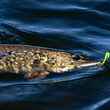
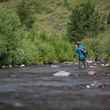





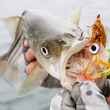










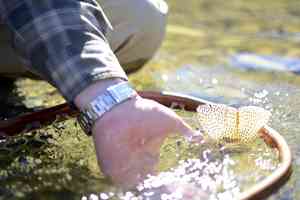
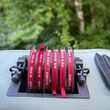

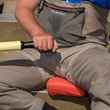
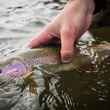


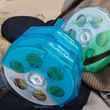
Comments